
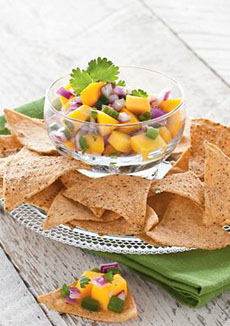
Mango salsa. Photo courtesy Harry & David.
April 2007
Last Updated July 2014
|
 |
Mexican Salsa & Other Salsa Types
Salsa Glossary Page 2: Salsa Terms E~N
Here you’ll find salsas including guasacaca, Mexican salsa and mole. This is Page 2 of a four-page article. Click on the black links below to visit other pages. See all of our delicious food glossaries.
This glossary is protected by copyright and cannot be reproduced in whole or in part. You are welcome to link to it.
EPAZOTE
Pronounced ay-pah-ZOE-teh, an indigenous herb common to Mexican cooking. The fresh herb has a strong, citrusy aroma and a subtle, sweet flavor. It is used in bean and chili dishes, soups and moles. |
|
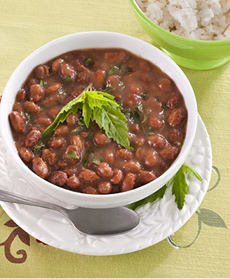
An epazote garnish on a bean dish. Photo courtesy Bonnie Plants. |
GUACAMOLE
Pronounced gwa-kah-MOH-lay, a sauce or dip made by mashing together avocados, tomatoes, chiles, onions, lime juice and cilantro, spiced with chili powder and cayenne pepper. Guacamole can be used as a dip, sauce, topping or side dish.
GUASACACA
Pronounced gwa-sah-KAH-kah, a sauce served with meat and fish in Venezuela. It is similar to guacamole (see definition above), including avocado, chopped onion and green pepper, garlic, parsley and cilantro. Olive oil and red wine vinegar are added to make a thinner sauce, and habanero chile is added for spiciness.
MANGO SALSA
One of the most popular fruit salsas. Make mango salsa by substituting diced fresh mango for the peaches in our peach salsa recipe. You can also add diced mango to a salsa fresca or a salsa roja.
|
|
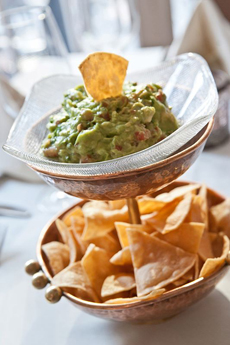
While most Americans think of guacamole as a dip, in Mexico it is also used as a sauce for meat and poultry. Photo courtesy Sandoval Restaurant | NYC.
|
MEXICAN SALSA
Mexican salsa, or Mexican sauce, can refer to pico de gallo. Otherwise, there is no one “Mexican salsa” style; each region has its own style. Some are red salsas (salsa roja, tomato-based), some are green salsas (salsa verde, tomatillo based). Read through this glossary and you’ll find more information on, and examples of, both styles.
MOLE
Pronounced moh-LEH and called the “royal sauce,” mole is made from roasted, rehydrated dried chiles, mixed with spices, unsweetened chocolate and almonds. It is smooth, thick, rich, nutty and pungent. The word comes from the Nahuatl (Aztec language) molli, meaning sauce. There are as many variations of moles as there are curries in India: Each region of Mexico has its own recipes and each family has its proprietary recipe. Two of the most famous: (1) Mole negro from Oaxaca, which uses the base ingredients plus peanuts, plantains, cloves, cinnamon, onion, garlic, sesame seeds and five different chiles. (2) Mole poblano from Pueblo, which uses the base ingredients plus tomatoes, raisins, bread, lard, anise, cloves, cinnamon, three different chiles, garlic, sesame and other ingredients. The sauces accompany beef, chicken, enchiladas, seafood and turkey, and are served with rice and tortillas. Try these braised beef tacos in mole sauce.
|
|
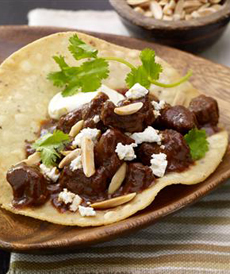
If you don’t have the time or
inclination to make a mole sauce (here’s the recipe in the photo), you can buy one in a bottle.
|
MOLHO MALAGUETA
Pronounced MOLL-yo mah-la-GWAY-tah, malagueta is the most common chile in Brazil, and is used to make a spicy vinaigrette that is sprinkled on food. It is made with one cup of fresh or dried malagueta chiles, stems removed and left whole, added to a clean wine bottle with a cup of vinegar. The bottle is topped off with palm oil (since palm oil is very high in fat, olive oil can be substituted). Tabasco or piquin chiles (pequin or birds-eye chiles) be substituted for the malagueta chiles. More about the malagueta chile.
|
|
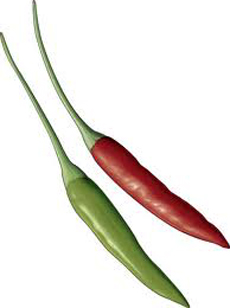
Malagueta chiles. Photo courtesy Birds-Eye.
|
Continue To Page 3: Salsa Terms With P~R
Go To The Article Index Above
If you have additions or suggestions for this glossary, use the Contact Us link on this page to let us know.

|








